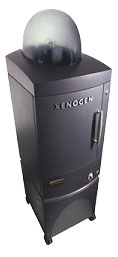Biophotonics

The biophotonics system is a high-efficiency optical imaging camera (IVIS Spectrum, Caliper Life Sciences) originally developed by Xenogen. This system provides non-invasive spatial and longitudinal monitoring of disease progression, cell trafficking and gene expression patterns in living animals.
The IVIS Spectrum at the SARIC contains an optimized set of high efficiency filters and spectral un-mixing algorithms for detecting luminescent or fluorescent reporters across the blue to near infrared wavelength region. The IVIS Spectrum is capable of either trans-illumination (from the bottom) or epi-illumination (from the top) to illuminate in vivo fluorescent sources. Fluorescent 3-D tomography can be performed to determine source localization and concentration using the combination of structured light and trans-illumination fluorescent images.
The instrument is equipped with 12 narrow band excitation filters (35 nm bandwidth) and 24 narrow band emission filters (20 nm bandwidth) that assist in significantly reducing autofluorescence by the spectral scanning of filters and unmixing algorithms. The spectral unmixing tools also allow the researcher to separate signals from multiple fluorescent reporters within the same animal.
Imaging platforms for either rat or mouse imaging have species-appropriate nosecones for inhaled isofluorane anesthesia which is provided through an integrated delivery system. The core facility does not supply fluorophores, luminescent substrates, or injectable anesthetics.
The following are suggested algorithms for luciferin preparation and luciferin detection as well as a fluorescent probe reference that describes the excitation/emission spectral peaks for a broad range of fluorochromes.